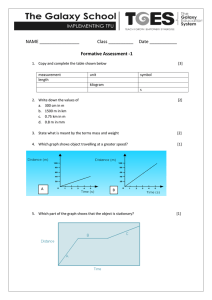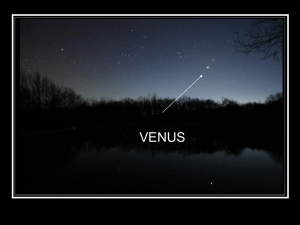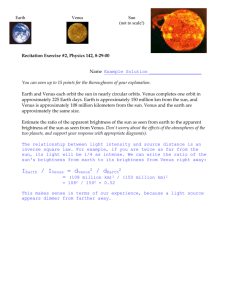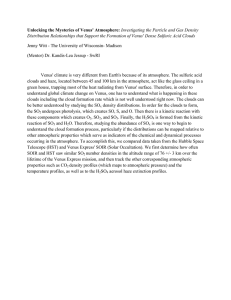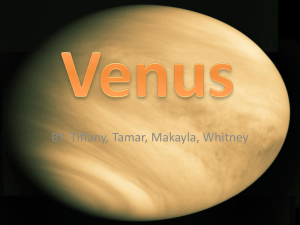High resolution IR and UV imaging of Venus Abstract
advertisement
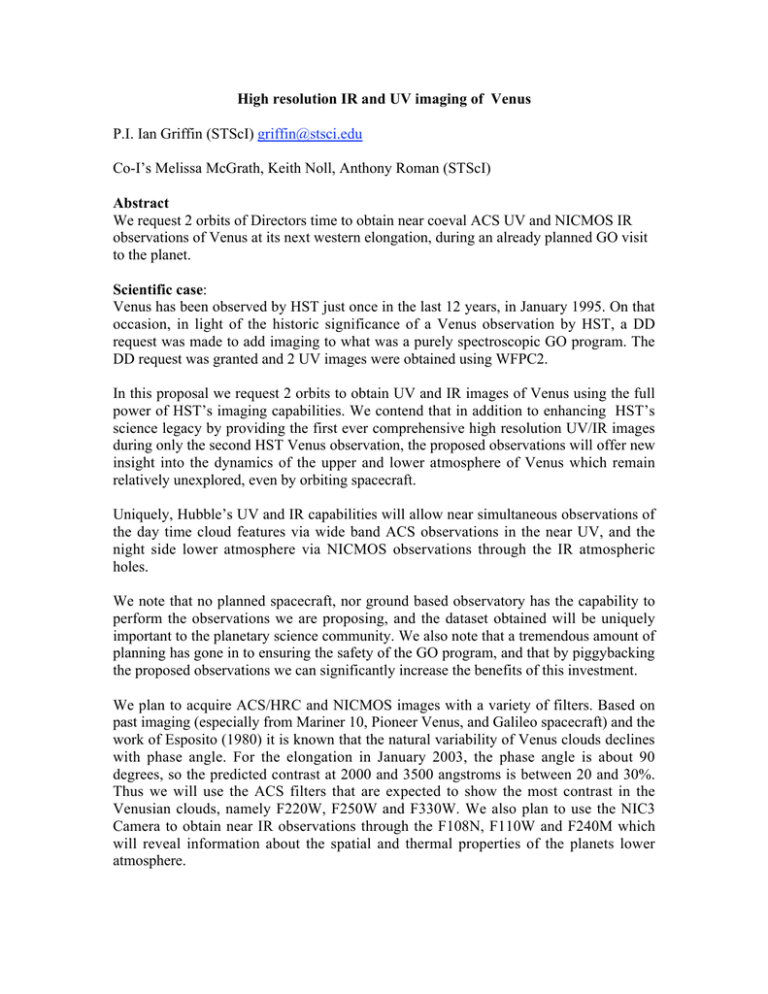
High resolution IR and UV imaging of Venus P.I. Ian Griffin (STScI) griffin@stsci.edu Co-I’s Melissa McGrath, Keith Noll, Anthony Roman (STScI) Abstract We request 2 orbits of Directors time to obtain near coeval ACS UV and NICMOS IR observations of Venus at its next western elongation, during an already planned GO visit to the planet. Scientific case: Venus has been observed by HST just once in the last 12 years, in January 1995. On that occasion, in light of the historic significance of a Venus observation by HST, a DD request was made to add imaging to what was a purely spectroscopic GO program. The DD request was granted and 2 UV images were obtained using WFPC2. In this proposal we request 2 orbits to obtain UV and IR images of Venus using the full power of HST’s imaging capabilities. We contend that in addition to enhancing HST’s science legacy by providing the first ever comprehensive high resolution UV/IR images during only the second HST Venus observation, the proposed observations will offer new insight into the dynamics of the upper and lower atmosphere of Venus which remain relatively unexplored, even by orbiting spacecraft. Uniquely, Hubble’s UV and IR capabilities will allow near simultaneous observations of the day time cloud features via wide band ACS observations in the near UV, and the night side lower atmosphere via NICMOS observations through the IR atmospheric holes. We note that no planned spacecraft, nor ground based observatory has the capability to perform the observations we are proposing, and the dataset obtained will be uniquely important to the planetary science community. We also note that a tremendous amount of planning has gone in to ensuring the safety of the GO program, and that by piggybacking the proposed observations we can significantly increase the benefits of this investment. We plan to acquire ACS/HRC and NICMOS images with a variety of filters. Based on past imaging (especially from Mariner 10, Pioneer Venus, and Galileo spacecraft) and the work of Esposito (1980) it is known that the natural variability of Venus clouds declines with phase angle. For the elongation in January 2003, the phase angle is about 90 degrees, so the predicted contrast at 2000 and 3500 angstroms is between 20 and 30%. Thus we will use the ACS filters that are expected to show the most contrast in the Venusian clouds, namely F220W, F250W and F330W. We also plan to use the NIC3 Camera to obtain near IR observations through the F108N, F110W and F240M which will reveal information about the spatial and thermal properties of the planets lower atmosphere. The first spatially resolved near IR images of Venus at 1.74 and 2.3 microns (Allen and Crawford 1983) revealed high contrast markings produced when thermal radiation from the hot lower atmosphere escapes through differing optical depths in the planet shrouding cloud layers. Further space borne and ground based studies revealed further spectral windows between 1 and 5 microns which have been used to learn more about the structure of the Venusian atmosphere. (see review by Taylor et.al 1996) Remote sensing in the near IR probes the properties of the lower cloud layers on Venus. To date, the highest resolution map of the 2.3 micron emission from the Cytherian atmosphere was made by the NIMS instrument aboard the Galileo spacecraft. (Carlson etal. 1993). With a resolution of 25km per pixel, the NIMS data have approximately five times the resolution of the proposed Hubble observations. However, as can be seen from Figure 1 below, even degraded to the expected resolution of Hubble, significant structure will be resolved. Galileo view at 2.3 microns Simulated HST view Since the Galileo encounter with Venus lasted only 2 days, the NIMS data give no information about the long term evolution of global structure in the middle and lower atmosphere of the planet. With no space missions to the planet imminent, and with the difficulty of observing Venus from the ground (even with AO) we feel this is an important opportunity to break new ground in the study of Venus. Coupled with the already approved cycle 9 spectroscopic program, this entire imaging and spectroscopic dataset will be of lasting value to the planetary science community, and will put the already approved GO program into spatial context. We also note that given the tremendous amount of planning that has been involved to ensure that the cycle 9 spectroscopic observations can be executed safely it seems logical to take advantage of all this planning and obtain some extra imaging data. The UV and IR observations will be used to study the stratosphere and the thermosphere of Venus. They will allow the GO observations to be put into spatial context, while also providing important observational constraints for multi-dimensional dynamical modeling of the planet’s thermosphere and the stratosphere. Additional information: While we believe we have built a compelling scientific case above, we note that there is an obvious and strong public and education case in support of this proposal. On January 26th 2003, for only the second time in the history of the Space Telescope Program, HST will be pointed at Venus, when program GO program 8659 is executed.. This program (whose PI is Mark Bullock) aims to obtain a high resolution STIS spectrum of Lyman-a and will assess the abundance of deuterium and constrain models of the planet’s atmosphere and climate evolution. Despite the rarity of HST Venus visits, no imaging was planned for this program, perhaps because it was originally proposed to execute in cycle 9, when only WFPC2 was available. Things have changed. With a completely different, more extensive and fully functioning suite of imaging instruments now working on HST, and a significantly better understanding of how to handle Venus observations thanks to the hard work of the planning team, it is our contention that this well planned and safe HST visit to Venus offers an unparalleled opportunity for the HST program to add to its very small inventory of Venus images. Given that this may well be the last ever Venus pointing made by the telescope, the HST project owes it to history to document this visit in the most comprehensive manner possible. We assert that the proposed legacy images of Venus while being of important science interest will also be of immeasurable and lasting value to the public and education communities. With Venus blazing in the eastern sky before sunrise in January, how better could we demonstrate the power of HST than by sharing 3 color UV and IR images of the closest planet, and telling the fascinating story of how the telescope uses “Dracula mode” to creep up and snap images of its prey then hurries to safety before the sun rises? To summarize, we feel that this proposal would have wide public appeal since it would be the first planetary target imaged by the ACS, it will provide the highest resolution images of Venus ever obtained from Earth, and the NICMOS imagery promises to show Venus in a "new light". In short we feel a wonderful education vignette can be built around the proposed observations and the story of how they are obtained by the skilled team of HST planners. Observing strategy: We will take advantage of all of the planning involved in obtaining GO program 8659, which gives an 11 minute window in each orbit for Venus observation. At the epoch of observation, the planet will be just over 50% illuminated, with the following physical parameters: Sun angle: 46.00 degrees Apparent magnitude: -4.4 Surface brightness: +1.5 (average for 1 square arc second of illuminated portion of disk) Apparent diameter: 21.12 arc seconds Phase angle: 81.24 degrees The UV data: We will observe Venus using the HRC on ACS, taking care to avoid the fastie finger! The ACS observations, which will cover the entire illuminated Venus disk, will allow the STIS spectra to be put into context relative to bright and dark UV markings. Observations through 3 filters wavelengths (F220W, F250W and F330W) will enable a 3 color image of the planet to be made, detailing cloud structure on the illuminated hemisphere. We will obtain 2 dithered images using each of the F220W and F250W filter in filter wheel 2. We request the HRC Clear filter (HRC CLEAR1S) in filter wheel 1. Using the ETC on the ACS webpage, we find that a s/n ratio of 750 can be reached with an exposure of 60 and 6.6 seconds through the 220W and 250W filters respectively. We will follow these exposures with a two 1 second exposures using the F330W filter in filter wheel 2. These calculations are appended below. The IR Data For NICMOS we would use NIC3 SCAMMER multi accumulation sequence with 10 exposures in the F108N, F240M and F110W filters. These data, obtained in pass bands close to the Venusian atmospheric windows, will provide spatial information on the structure of the planet’s lower atmosphere. References: Allen, D. & Crawford, J. 1984, Nature 307:222-224 Carlson, R. et. al, Planet. Space Sci. 41(7):475 (1993) Esposito, L. JGR 85 8151-8157 (1980) Taylor, F. W. et. al, Venus II, University of Arizona Press, 1996 Exposure time calculations: Note that these assume a solar analogue spectrum with Venus being an extended source with V=1.5 magnitude per square arc second. We note also that during the last visit to Venus, in 1995, the exposures used were 2 seconds at 2550 angstroms and 20 seconds at 218 angstroms respectively. F220W Filter S/N Ratio and Exposure time: Exposure time = 60 seconds S/N = 786.9 Optimal S/N = 0.0 WFC/HRC Integrated Countrate Analysis The brightest pixel in a single image would have 7.74e+04 electrons (3.87e+04 ADU). Breakdown of Detected Counts Origin Signal Source 6.194e+05eSky background 0.02065eDetector dark current 0.6eThe S/N ratio calculations are based upon counts within a square aperture of 2x2 pixels The observational parameters for this calculation were: Detector = hrc Filter = f220w Gain = 2 e-/ADU CR-split (Total number of images) = 2 Target was an extended source. Source spectrum: Standard Star Spectrum Solar Source Flux: v/arcsec2 = 1.5 Average Galactic Extinction of E(B-V) = 0.0 The Zodical Light is average The Earthshine is average F250W filter S/N Ratio and Exposure time: Exposure time = 6.599 seconds S/N = 750 Optimal S/N = Not used. WFC/HRC Integrated Countrate Analysis The brightest pixel in a single image would have 7.03e+04 electrons (3.52e+04 ADU). Breakdown of Detected Counts Origin Signal Source 5.627e+05e- Sky background 0.006573e- Detector dark current 0.066eThe S/N ratio calculations are based upon counts within a square aperture of 2x2 pixels The observational parameters for this calculation were: Detector = hrc Filter = f250w Gain = 2 e-/ADU CR-split (Total number of images) = 2 Target was an extended source. Source spectrum: Standard Star Spectrum Solar Source Flux: v/arcsec2 = 1.5 Average Galactic Extinction of E(B-V) = 0.0 The Zodical Light is average The Earthshine is average F330W filter S/N Ratio and Exposure time: Exposure time = 1.007 seconds S/N = 750 Optimal S/N = Not used. WFC/HRC Integrated Countrate Analysis The brightest pixel in a single image would have 7.03e+04 electrons (3.52e+04 ADU). Breakdown of Detected Counts Origin Signal Source 5.628e+05e- Sky background 0.002268e- Detector dark current 0.01eThe S/N ratio calculations are based upon counts within a square aperture of 2x2 pixels The observational parameters for this calculation were: Detector = hrc Filter = f330w Gain = 2 e-/ADU CR-split (Total number of images) = 2 Target was an extended source. Source spectrum: Standard Star Spectrum Solar Source Flux: v/arcsec2 = 1.5 Average Galactic Extinction of E(B-V) = 0.0 The Zodical Light is average The Earthshine is average The IR Data For NICMOS we would use NIC3 SCAMMER multi accumulation sequence with 10 exposures in each of the following filters F108N S/N and Exposure time: • • Exposure time = 0.3412 seconds S/N for the brightest pixel = 1000 The observational parameters for this calculation were: Target was an extended source. S/N was calculated for one pixel. • • • • • • • • • • • • • Detector = NIC3 Detector temperature (K) = 77.10 Filter = f108n Spectrum: G2V (Model Spectrum) Source Flux: v/arcsec**2 = 1.5 Average Galactic Reddening ( E(B-V) ) = 0.0 The Zodiacal Light is average The Earthshine is average Total counts from the source(e per s) = 7.33e+07 Telescope thermal background (e per s per pixel) = 0.000 Sky background (e per s per pixel) = 0.018 • • • • • • Dark current (e per s per pixel) = 0.300 Number of Multiple Initial and Final read(s): 1 Read noise with 1 end-point read (e): 26 Saturation in electrons = 185000 Exposure time to saturate (s) = 0.063 F240M S/N and Exposure time: Exposure time = 0.0002893 seconds S/N for the brightest pixel = 100 The observational parameters for this calculation were: Target was an extended source. S/N was calculated for one pixel. Detector = NIC3 Detector temperature (K) = 77.10 Filter = f240m Spectrum: G2V (Model Spectrum) Source Flux: v/arcsec**2 = 1.5 Average Galactic Reddening ( E(B-V) ) = 0.0 The Zodiacal Light is average The Earthshine is average Total counts from the source(e per s) = 9.19e+08 Telescope thermal background (e per s per pixel) = 497.603 Sky background (e per s per pixel) = 0.285 Dark current (e per s per pixel) = 0.300 Number of Multiple Initial and Final read(s): 1 Read noise with 1 end-point read (e): 26 Saturation in electrons = 185000 Exposure time to saturate (s) = 0.005 F110W S/N and Exposure time: Exposure time = 5.85e-05 seconds S/N for the brightest pixel = 100 The observational parameters for this calculation were: Target was an extended source. S/N was calculated for one pixel. Detector = NIC3 Detector temperature (K) = 77.10 Filter = f110w Spectrum: G2V (Model Spectrum) Source Flux: v/arcsec**2 = 1.5 Average Galactic Reddening ( E(B-V) ) = 0.0 The Zodiacal Light is average The Earthshine is average Total counts from the source(e per s) = 4.55e+09 Telescope thermal background (e per s per pixel) = 0.000 Sky background (e per s per pixel) = 1.130 Dark current (e per s per pixel) = 0.300 Number of Multiple Initial and Final read(s): 1 Read noise with 1 end-point read (e): 26 Saturation in electrons = 185000 Exposure time to saturate (s) = 0.001


